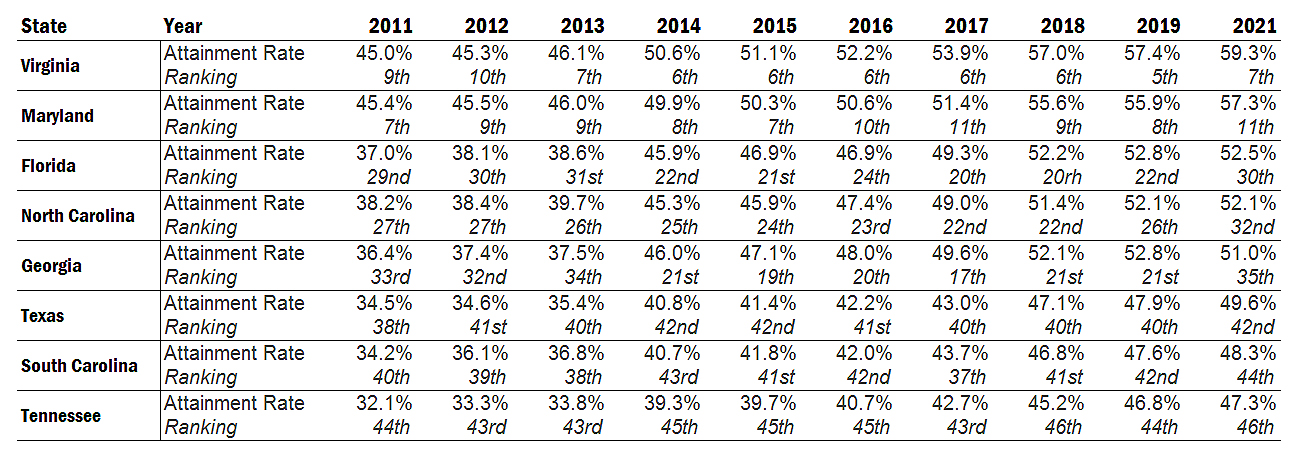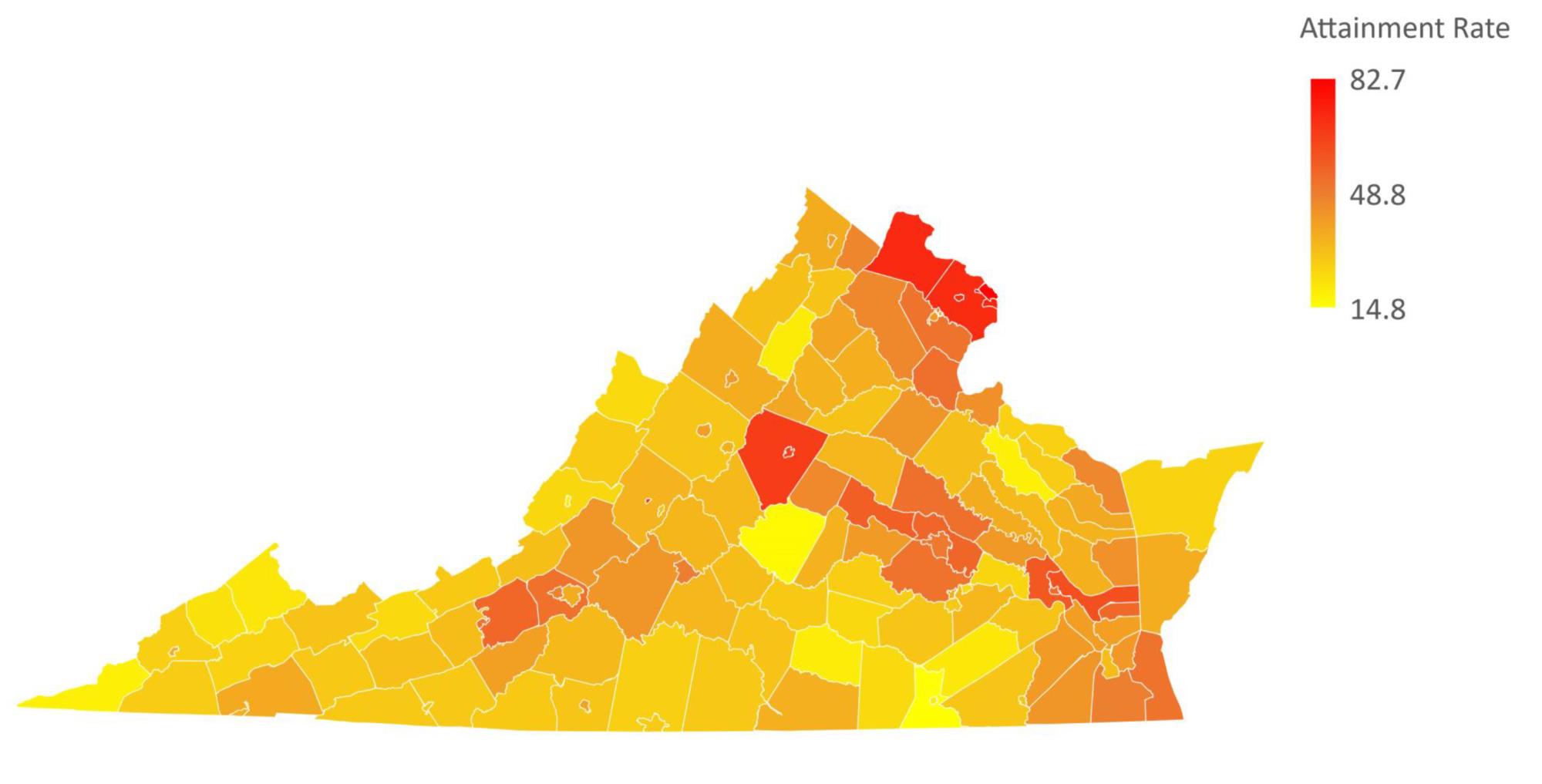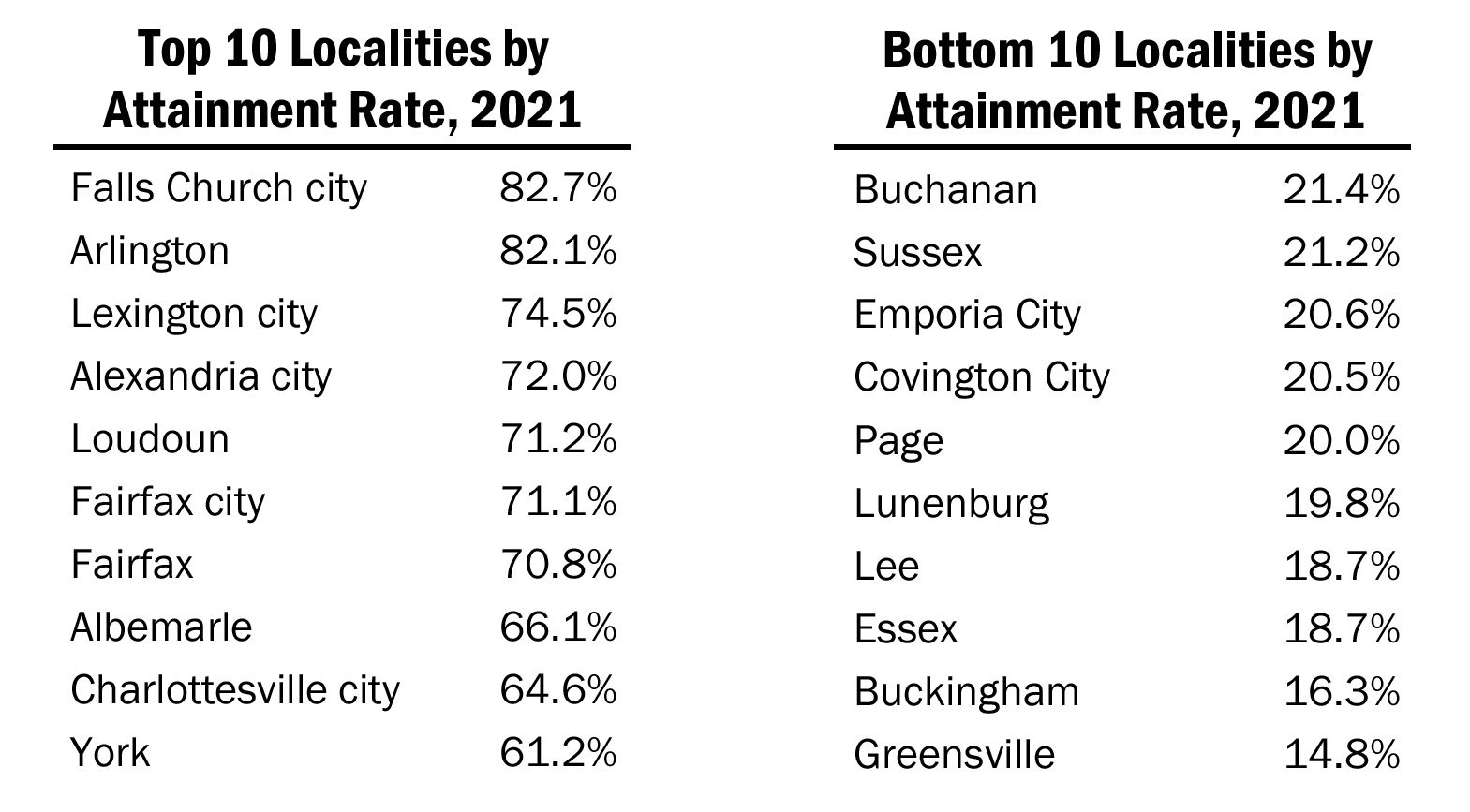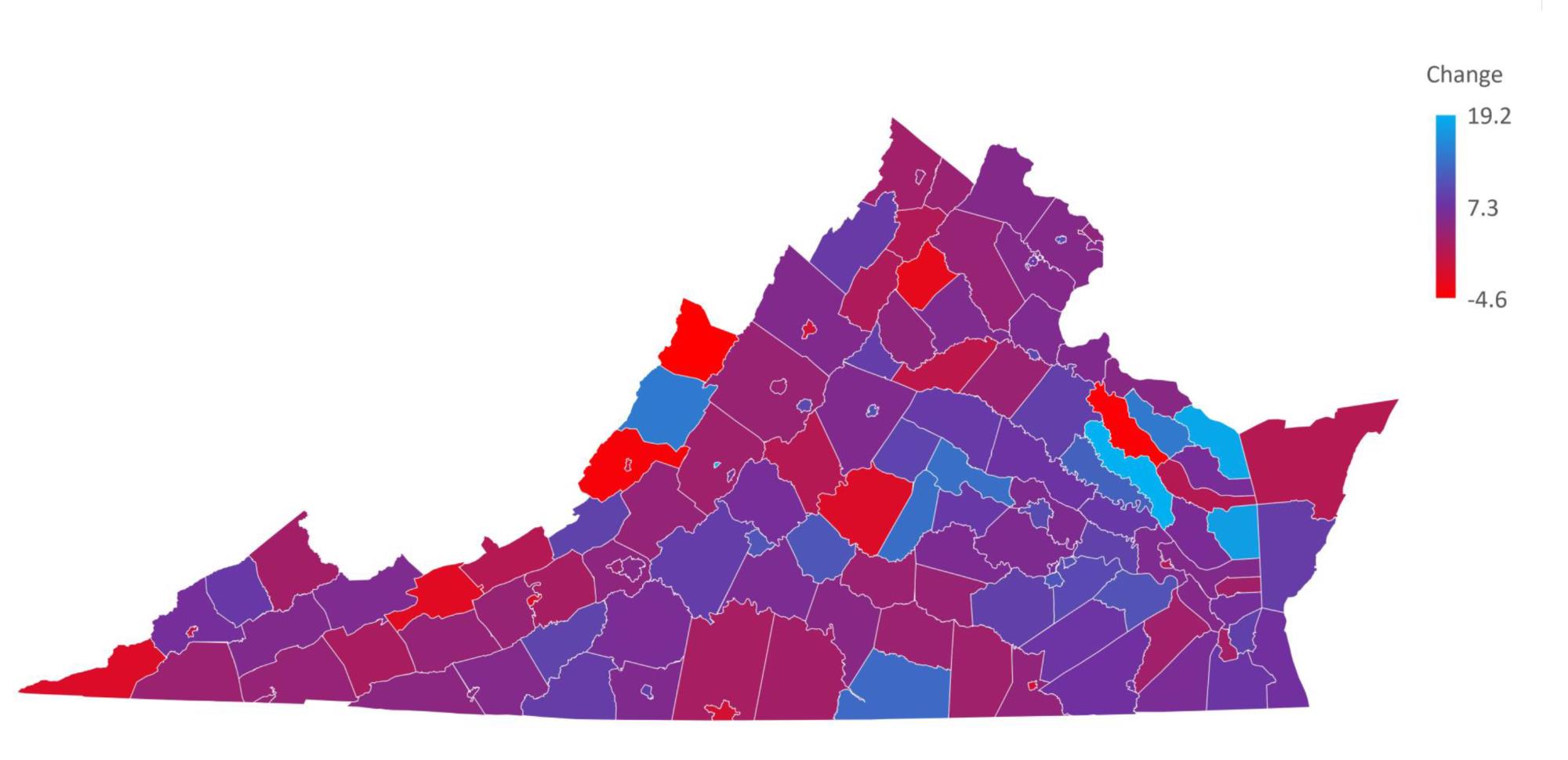By
Tom Allison
Evan Price
New data from the Lumina Foundation show that more Virginians have pursued education or training than ever before. The report finds that, in 2021, 59.3% of working-aged Virginians had earned a college degree or postsecondary certificate or credential, a two-point increase from 2019. (Lumina did not release 2020 estimates due to the COVID-19 pandemic.) Virginia ranks 7th in the nation in terms of postsecondary education attainment. This ranking is a dip from 5th two years ago, due to faster attainment rate growth in New Jersey and Utah.
Postsecondary attainment comes with economic and social benefits: College graduates earn higher wages, are more likely to have health insurance, pay taxes, vote and volunteer, and are less likely to rely on public assistance. Pathways to Opportunity, Virginia's strategic plan for higher education, sets a target of achieving the 70% attainment rate for working aged Virginians by 2030. While the state as a whole continues to increase educational attainment, Virginia still faces significant gaps by region and demography.
State Rankings
Statewide, 59.3% of working-aged Virginians earned a postsecondary degree or credential in 2021. Compared to other states, that places Virginia 7th, down from 5th in 2019 and up from 9th in 2011. The following table shows Virginia’s and selected states’ attainment rates, as well as nationwide attainment rankings.
Table 1: Virginia and selected states’ attainment rates and rankings.

Attainment rate includes college degrees and certificates and credentials. Lumina Foundation did not release estimates in 2020.
Source: Lumina Foundation, Stronger Nation
Virginia’s increasing attainment rate and ranking continues to move us toward our target of a 70% attainment rate by 2030.
Locality
Education attainment varies widely by locality in Virginia. The following map compares cities’ and counties’ attainment rates in 2021. (Attainment in this case refers to only associate degrees and above; credentials are not counted.)
Chart 1: 2021 Educational Attainment Rate (Associate Degree and above) by Virginia Locality

Source: Lumina Foundation, Stronger Nation
As demonstrated by the map, significant gaps in attainment rates exist both between localities and by region especially. The following two charts rank the top and bottom 10 localities by attainment rate in 2021.
Table 2: Top and Bottom Localities by Attainment Rate (Associate Degree and above)

Source: Lumina Foundation, Stronger Nation
Falls Church City’s attainment rate of 82.7% is more than double that of 94 cities and counties in Virginia. York County (the 10th highest) has an attainment rate more than double that of 44 cities and counties.
For comparison, the range between the attainment rate extremes of Falls Church City and Greensville County (a 67.9 point gap in 2021) is larger than the range in Maryland and North Carolina. In Maryland, the largest gap exists between Howard and Dorcester Counties. Howard County, situated roughly halfway between Washington, D.C. and Baltimore, had an attainment rate of 71.5% in 2021. Dorcester County, situated on Maryland’s eastern shore, had an attainment rate of 24.6%, resulting in a 46.8 point gap. In North Carolina, the largest gap is between Orange and Tyrell Counties. Orange County had an attainment rate of 70.0%. Tyrell County, a county of around 3,000 people near the coast, had an attainment rate of 16.6%. That range equates to a 53.4 point difference.
The following map shows the point change in attainment rate for each independent city and county between 2011 and 2021.
Chart 2: Education Attainment Point Change by Locality, 2011-2021

(Note: Bedford City reverted to a town from an independent city in 2013. Its attainment rate was removed from the dataset to avoid confusion.) Source: Lumina Foundation, Stronger Nation
Race/Ethnicity
Lumina Foundation also publishes attainment rate estimates by race and ethnicity. Over the past decade (since 2011) every subgroup has seen an increase in attainment, though some more pronounced than others. It should be noted that this attainment rate includes only associate degrees and above, as does the data used for localities’ attainment rate.
Table 4: Attainment Rate (Associate Degree and Above) by Race/Ethnicity in Virginia 2021
Source: Lumina Foundation, Stronger Nation
Note also that the attainment rate for Asian Virginians is more than double that of Hispanics living in Virginia, and almost double that of African American or Black Virginians. The gap between the subgroup with the highest attainment rate and the lowest has remained mostly stable over the past decade.
Chart 3: Change in Attainment Rate (Associate Degree and Above) by Race/Ethnicity
Source: Lumina Foundation, Stronger Nation
The following table shows the 10-year increase in attainment rate by the race/ethnicity subgroup:
Table 5: Attainment Rate (Associate Degree and Above) Point Change by Subgroup
Source: Lumina Foundation, Stronger Nation
Conclusion
Virginia has one of the highest education attainment rates in the country. In 2021, the percentage of working-aged Virginians with a postsecondary degree or credential grew by nearly two points. While Virginia's nationwide rank slipped two places, this is largely due to faster population growth in New Jersey and Utah. There are also significant gaps in attainment by locality and race/ethnicity. Pathways to Opportunity, The Virginia Plan for Higher Education focuses on closing these gaps.
A state’s attainment rate is impacted not only by individuals earning degrees and credentials, but also whether a state can keep them or recruit them to move. Much attention has been paid recently to the mobility of college graduates. SCHEV, in conjunction with VEDP, found that the net migration of Virginians with a bachelor's degree was within the margin of error. A SCHEV report also found that 74% of in-state graduates over a 10-year period of public institutions were found living in the state. Only 20% of out-of-state graduates stayed in Virginia, however, so clearly there is room for progress on recruitment.
To remain competitive and reach the Pathways to Opportunity Plan’s overall target of 70% attainment, Virginia needs to continue increasing its education attainment rate while closing gaps by geography and demographics. It is also important to retain graduates of Virginia institutions and recruit talent from other states.
Welcome to Insights, SCHEV's platform to interpret and communicate data and policy with the overall goal of informing policy-making, engaging institutions and drawing attention to these resources. Centered around SCHEV's nationally leading data collection, each Insight will visualize complex ideas and help inform funding and policy decisions.
